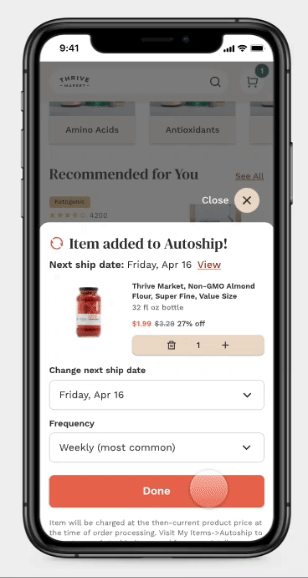ABOUT
The introduction of Autoship, a subscription service option to Thrive Market, had a great impact to the company business. However, its complexity created some pains to the user experience that we needed to address.
Team
Lauren Braen: Product Manager
James Meeks: Head of Product and Design
My Role
Digital Product Designer (2020 - 2021)
Usability tests
Design for A/B tests
Time and Place
June 2021
Los Angeles, California
About Autoship
Described as "Costco meets Whole Foods", Thrive Market's business model is designed to simplify the supply chain of healthy and organic foods by eliminating the markup typically applied by brick-and-mortar grocery stores.
Autoship is Thrive Market’s recurring shipment service. Customers can add items to Autoship, deciding on quantity, next ship date and frequency, and then get shipped their subscription boxes accordingly.
During my experience at Thrive Market, Autoship went from being a secondary business unit to the core business for the company. And I was the product designer assigned to it.
The Opportunity: Auto Opt-in
As part of a business strategy decision, new Thrive Market members where automatically opted-in to the recurring deliveries shopping model, which, compared to the Manual Opt-in variant, resulted in:
39% higher engagement in the Autoship program
30% higher Revenue/Member/Day
17% higher drops from the program but with twice of CVR at the long term
This is what we called ‘Autoship 2.1’
The Challenges
The implementation of Autoship 2.1 in parallel to the regular shopping cart created pains for the experience. Some examples of customer feedback themes:
Having two carts (main shopping cart AND next shipment cart) created confusion.
Adding items from the cart to the next shipment cart created duplicated items shipped to our customers
Uncertainty of when customers would receive their first order
One of the common themes of customer feedback was the unexpected duplication of items showing up within both shopping carts.
IMPROVEMENT Example #1
Navigation Refactor
Something we quickly thought about when trying to reduce the confusion of having two carts was to re-organize the product’s navigation, looking for a possibility to surface Autoship Next Shipment to the top level. Our hypothesis was that if we made it more accessible, customers would understand better the difference between Cart and Next Shipment.
Methodology
Task-driven, unmoderated preference test sessions comparing:
Control: current experience (Autoship hidden within My Items)
Variant: surfacing Autoship to the main navigation
Target Audience: Autoship active users, n=10
Control: Cart in top right and Autoship under My Items. To access Autoship, users had to click on My Items.
Variant A: Surfacing Autoship under bottom navigation, instead of ‘Deals’
Results
4/10 did not notice the difference* between Variant A and Control
Out of 6/10 who saw the difference, all preferred the Variant A
Usability Test Takeaways
This usability test gave us confidence that the change had the potential of improving the experience, and that resulting in higher engagement with Autoship, hence higher customer lifecycle value. We proposed an A/B test replicating the experiment but in a quantitative way, and given its proven success, we changed the navigation for all of our customers.
Improvement example #2
Improved Confirmation Sheet
On the received feedback about customers not being sure about dates in which they would be receiving items added to Autoship, we improved the confirmation sheet, to include besides quantity:
The ability to change for which shipment they would like to include it next
With which frequency they would like to receive the item
The ability delete the item in case they wanted to
As all features in Thrive Market, we soft-launched this improvement through a controlled A/B Test, starting with 5% of traffic, and once verified KPI improvements and stability, we ramped to 100%.
General Conclusion and Takeaways
Autoship was a great challenge to be assigned to as a designer. I had the opportunity to work on a key business for the company, a complex experience for customers, and to work arm to arm with different stakeholders such as Product Manager, Developers, Business Planners, and Data Scientists.
The shared above examples, are just a few of all improvements we worked on sprint after sprint.












